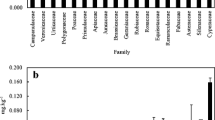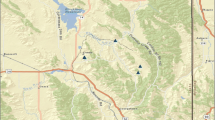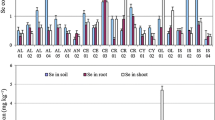Abstract
A study was undertaken to assess the potential of two plant species, tall fescue (Festuca arundinacea Schreb., a forage plant) and yellow sour clover (Melilotus indica L., a naturally occuring legume species) for bioremediation of selenium laden soils. Using soil columns under simulated field soil conditions, the effects of these two species were studied on soil selenium (Se) redistribution, leaching, and Se bioextraction. Both leachate volume and Se concentration in the leachate were greatly influenced by presence of vegetation. The volume of leachate was considerably lower for columns having either tall fescue or yellow sour clover plantings. Tall fescue had a higher water use rate and greater rooting density than did in yellow sour clover, indicating the tall fescue will be more practical for bioremediation of Se laden soils.
Soil Se distribution analysis yielded the following patterns: (1) contamination of the lower soil profile of uncontaminated soil occurred at the first harvest, but Se concentrations at these depths were not at high levels; (2) except for selenite, all forms of water-extractable soil Se concentrations showed a clear reduction over time of vegetation harvest; and (3) the reductions of total soil Se were significant, but the difference was relatively small between the forage planting and bare soil treatments. This is due to the fact that only a relatively small fraction of total Se inventory was water soluble and available to plants at any one time. A large reduction may become apparent after a longer period of forage plant management.
Similar content being viewed by others
References
Ahlrichs JS, Hossner LR (1987) Selinite and selenate mobility in overburden by saturated flow. J Environ Quality 16:95–98
Alemi MH, Goldhammer DA, Nielsen DR (1988) Selenate transport in steady-state, water saturated soil columns. J Environ Quality 17:608–613
Bañuelos GS, Mead R, Wu L, Beuselinck P, Akohoue S (1992) Differential selenium accumulation among forage plant species from soils amended with selenium-enriched plant tissue. J Soil Water Cons 47:338–342
Bañuelos GS, Cardon G, Mackey B, Ben-Asher J, Wu L, Beuselinck P, Akohoue S, Zambrzuski S (1993) Boron and selenium removal in boron-ladon soils by four sprinkler irrigated plant species. J Environ Quality 22:786–797
Davis EB, Watkinson JH (1969) Uptake of native and applied selenium by pasture species: Effects of sulfate and soil type on uptake by clover. New Zealand J Agric 9:641–652
Fuji R, Deverel SJ (1989) Mobility and distribution of selenium and salinity in groundwater and soils of drained agricultural fields, western San Joaquin Valley of California. In: Selenium in Agriculture and the Environment. In: Jacobs LW (ed) American Society of Agronomy and Soil Science Society of America, Madison, pp 195–212
Fio JL, Fuji R, Deverel SJ (1991) Selenium mobility and distribution in irrigated and nonirrigated alluvial soils. Soil Sci Soc Am J 55:1313–1320
Gissel-Nielsen G, Bisbjerg B (1970) The uptake of applied selenium by agricultural plants. 2. The utilization of various selenium compounds. Plant Soil 32:381–392
Gissel-Nielsen G (1973) Uptake and distribution of added selenite and selenate by barley and red clover as influenced by sulphur. J Sci Food Agric 24:649–655
HACH Company (1982) Sulfate: Turbidimetric Method, Water Analysis Handbook, Loveland, Colorado, pp 2–277
Läuchli A (1993) Selenium in Plants: Uptake, functions, and environmental toxicity. Botanica Acta 106:451–455
Mayland HF, Games LJ, Panter KE, Sonderegger JL (1989) Selenium in seleniferous environments. In: C.W.G. Jacobs (ed), Selenium in Agriculture and the Environment, SSSA Special Publication No. 23, Madison, WI, pp 15–50
McNeal JM, Balistrieri LS (1989) Geochemistry and occurrence of selenium; an overview: selenium in agriculture and th environment. SSSA Special Publication No. 23, Madison, WI, 1013 p
Mikkelsen RL, Mikkelsen DS, Abshahi A (1989) Effects of soil flooding on selenium transformations and accumulations by rice. Soil Sci Soc Am J 53:122–127
National Research Council (1980) Mineral tolerances of domestic animals. National Academy of Science, Washington, DC, p 477
Newman EI (1966) A method of estimating the total length of root in a sample. J Appl Ecol 2:139–145
Ohlendorf HM, Hoffman DJ, Salki MK, Aldrich TW (1986) Embryonic mortality and abnormalities of aquatic birds: Apparent impacts of selenium from irrigation drain water. Sci Total Environ 52:49–63
Ohlendorf HM (1989) Bioaccumulation and effects of selenium in wildlife. In Jacobs W (ed) Selenium in agriculture and the environment. Special Publication 23. Soil Science Society of America, Madison WI, pp 133–179
Parker DR, Page AL (1994) Vegetation management strategies for remediation of selenium-contaminated soils. In: Frankenberger WI Jr Benson S (eds) Selenium in the environment, Marcel Dekker NY, pp 327–347
Saiki MK (1986) A field example of selenium contamination in an aquatic food chain. Proceedings, First Annual Environmental Symposium, Selenium in the Environment, Fresno, CA, June 10–12, 1985, pp 67–76
Saiki MK, Lowe TP (1987) Selenium in aquatic organisms from subsurface agricultural drainage water, San Joaquin Valley, California. Arch Environ Contam Toxicol 19:496–499
Saiki MK, Ogle RS (1995) Evidence of impaired reproduction by western mosquitofish inhabiting seleniferous agricultural drain-water. Trans Am Fish Soc 124:578–587
Tennant D (1975) A test of a modified line intersect method of estimating root length. J Ecol 63:995–1001
Terry N, Zayed AM (1994) Selenium volatilization by plants: In: Frankenberger, Jr. and S. Benson (eds.) Selenium in the environment. Marcel Dekker, NY
Wu L, Huang ZH, Burau RG (1988) Selenium accumulation and selenium-salt cotolerance in five grass species. Crop Sci 28:517–522
Wu L, Huang ZZ (1991) Selenium accumulation and selenium tolerance of saltgrass from soils with elevated concentrations of selenium and salinity. Ecotoxicol Environ Saf 22:232–247
Wu L, Enberg A, Tanji KK (1993) Natural establishment and selenium accumulation of herbaceous plant species in soils with elevated concentrations of selenium and salinity under irrigation and tillage practices. Ecotoxicol Environ Saf 25:127–140
Wu L, Enberg A, Biggar JA (1994) Effects of elevated selenium concentrations on selenium accumulation and nitrogen fixation symbiotic activity of Melilotus indica L. Ecotoxicol Environ Saf 27:50–63
Wu L, Chen J, Tanji KK, Banuelos GS (1995) Distribution and biomagnification of selenium in a restored upland grassland contaminated by selenium from agricultiral drain water. Environ Toxicol Chem 14:733–742
Author information
Authors and Affiliations
Rights and permissions
About this article
Cite this article
Wu, L., Van Mantgem, P.J. & Guo, X. Effects of forage plant and field legume species on soil selenium redistribution, leaching, and bioextraction in soils contaminated by agricultural drain water sediment. Arch. Environ. Contam. Toxicol. 31, 329–338 (1996). https://doi.org/10.1007/BF00212671
Received:
Revised:
Issue Date:
DOI: https://doi.org/10.1007/BF00212671




